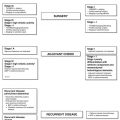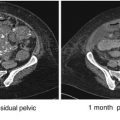Author (year)
N (Period recruitment /year)
Timing
Drug (mg/m2)
Mortality
PFS median months
OS median months
Cotte (2007) [39]
81 (14)
M
Cis (20)
2.5 %
19
28
Pavlov (2009) [40]
56 (12)
M
Doxo (O.1)
Cispl (15)
1.8 %
26
43 (primary)
40 (relapse)
Helm (2010) [41]
141
M
Platinum
Mito
0.5 %
16.6
30
Roviello (2010) [42]
53 (9)
M
Cispl (100)
Mito (25)
0 %
NR
55 % 5 years
Parson (2011) [43]
51 (13)
I
Carbo (1000)
Mito (30)
0 %
NR
29
Deraco (2012) [44]
56 (15)
R
Cispl (42)
Doxo (15)
Cispl (25)
Mito (3.3)
5.3 %
10.8
25.7
Bakrin (2013) [25]
566 (19)
M
Cispl
Oxaly
Doxo
Mito
0.8 %
NR
35.4
Robella M (2014) [45]
70 (17)
M
Cispl (100) – Doxo (15.2)
7 %
NR
48 (primary)
28 (relapse)
Konigstrainer (2014) [46]
62 (5)
R
Cispl (50)
0 %
NR
35 (CC0-1)
14 (CC2)
Coccolini (2015) [47]
54 (6.5)
M
Cispl (100) – Pacli (175)
0 %
12.4
32.9
Classe (2015) [33]
314 (10)
R
Cispl
Oxaly
Doxo
Mito
1 %
14 % 5 years
38 % 5 years
Those studies share some characteristics: heterogeneous drug, with different posology, heterogeneous HIPEC technique open or closed, different temperatures, and duration. Clinical situations are frequently mixed: frontline treatment of advanced disease, progression. Tools to describe postoperative morbidity are heterogeneous limiting accuracy of comparison of published series.
Bakrin et al. published the biggest retrospective series of 566 patients treated for a primary advanced ovarian cancer (n = 92) or a relapse, either first or more relapse (n = 474). Several main parameters were heterogeneous: step of the disease – primary treatment, first relapse, more than the first relapse – HIPEC parameters – drug, temperature, concentration, duration, completeness of cytoreductive surgery. Grade 3–4 morbidity rates were 0.8 % and 31.3 %, respectively. Median overall survivals were 35.4 and 45.7 months for advanced and recurrent EOC, respectively. A more recent paper, based on an extraction of the latest paper, focuses on a specific selection of patients with a first relapse [30]. Mortality and morbidity rates were, respectively, 1 % and 30.9 %. Median follow-up was 50 months, 5-year overall survival was 38.0 %, with no difference between platinum-sensitive and platinum-resistant patients, and 5-year disease-free survival was 14 %.
In these studies, the lack of control group prevents to point any specific advantage of HIPEC.
Ten studies of HIPEC for an ovarian cancer compared with a control group without HIPEC are already published (Table 6.2). The number of patients in each arm is very low with 14–60 in HIPEC group and 12–84 in no HIPEC group. Those studies share usual limitations as small effective, heterogeneous clinical situation with four studies in the situation of initial treatment and six in the situation of relapse and heterogeneous drug. The reason of the choice of treatment, HIPEC or not, was never due to a randomization.
Table 6.2
Series with control group
Stage | HIPEC drug | HIPEC (n) | No HIPEC (n) | |
|---|---|---|---|---|
Ryu (2004) [48] | Primary | Carboplatinum | 57 | 60 |
Gori (2005) [49] | Primary | Cisplatinum | 32 | 19 |
Bae (2007) [50] | Primary | Paclitaxel (22) Carboplatinum (45) | 67 | 29 |
Munoz casares (2009) [34] | Relapse | Paclitaxel | 14 | 12 |
Spilliotis (2011) [51] | Relapse | Cisplat/Pacli | 24 | 24 |
Warschkow (2012) [52] | Primary | Cisplatinum | 21 | 90 |
Fagotti (2012) [36] | Relapse | Oxaliplatinum | 30 | 37 |
Lebrun (2014) [37] | Relapse | Cisplatinum | 23 | 19 |
Safra (2014) [53] | Primary | Cisplat/Doxo Pacli/Carbo Cisplat/Mito | 27 | 84 |
Cascales campos (2015) [54]
Stay updated, free articles. Join our Telegram channel
Full access? Get Clinical Tree
 Get Clinical Tree app for offline access
Get Clinical Tree app for offline access

|



